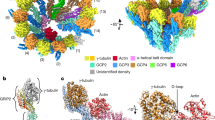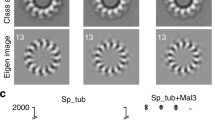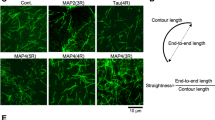Abstract
The interaction of microtubule associated proteins (MAPs) with the microtubule system has been characterized in depth in neuronal cells from various mammalian species. These proteins interact with well-defined domains within the acidic tubulin carboxyl-terminal regulatory region. However, there is little information on the mechanisms of MAPs-tubulin interactions in nonmammalian systems. Recently, a novel tau-like protein designated as DMAP-85 has been identified in Drosophila melanogaster, and the regulation of its interactions with cytoskeletal elements was analyzed throughout different developmental stages of this organism. In this report, the topographic domains involved in the binding of DMAP-85 with tubulin heterodimer were investigated. Affinity chromatography of DMAP-85 in matrixes of taxol-stabilized microtubules showed the reversible interaction of DMAP-85 with domains on the microtubular surface. Co-sedimentation studies using the subtilisin-treated tubulin (S-tubulin) indicated the lack of association of DMAP-85 to this tubulin moiety. Moreover, studies on affinity chromatography of the purified 4 kDa C-terminal tubulin peptide bound to an affinity column, confirmed that DMAP-85 interacts directly with this regulatory domain on tubulin subunits. Further studies on sequencial affinity chromatography using a calmodulin affinity column followed by the microtubule column confirmed the similarities in the interaction behavior of DMAP-85 with that of tau. DMAP-85 associated to both calmodulin and the microtubular polymer. These studies support the idea that the carboxyl-terminal region on tubulin constitutes a common binding domain for most microtubule-interacting proteins.
Similar content being viewed by others
Abbreviations
- MAPs:
-
microtubule-associated proteins
- C-terminal:
-
carboxyl-terminal
- SDS-PAGE:
-
polyacrylamide gel electrophoresis in the presence of SDS
- DTT:
-
dithiotreitol
- BSA:
-
bovine serum albumin
References
Maccioni RB, Seeds N: Affinity labeling of tubulin's GTP exchangeable site. Biochemistry 22: 1572–1579, 1983
Bershadsky A, Vasiliev J: ‘Cytoskeleton’. Plenum Press, New York, 298 pp, 1988
Olmsted JB: Microtubule associated proteins. Annu Rev Cell Biol 2: 421–458, 1986
Dinsmore JH, Solomon F: Inhibition of MAP-2 expression affects both morphological and cell division phenotypes of neuronal differentiation. Cell 64: 817–826, 1991
Kanai Y, Takemura R, Oshima T, Mori H, Ihara Y, Yanagisawa M, Masaki T, Hirokawa N: Expression of multiple tau isoforms and microtubule bundle formation in fibroblasts transfected with a single cDNA. J Cell Biol 109: 1173–1184, 1989
Serrano L, de la Torre J, Maccioni RB, Avila J: Involvement of the carboxyl-terminal domain of tubulin in the regulation of its assembly. Proc Natl Acad Sci USA 81: 5989–5993, 1984
Maccioni RB, Serrano L, Avila J, Cann JR: Characterization and structural aspects of the enhanced assembly of tubulin after removal of its carboxyl-terminal domain. Eur J Biochem 156: 375–381, 1986
Vera JC, Rivas C, Maccioni RB: Antibodies to synthetic peptides from the tubulin's regulatory domain interact with tubulin and microtubules. Proc Natl Acad Sci USA 85: 6763–6767, 1988
Cross D, Dominguez J, Maccioni RB, Avila J: MAP-1 and MAP-2 binding sites at the C-terminus of β-tubulin. Studies with synthetic peptides. Biochemistry 30, 4362–4366, 1991
Maccioni RB, Rivas C, Vera JC: Differential interaction of synthetic peptides from the carboxyl-terminal regulatory domain of tubulin with microtubule-associated proteins. EMBO J 7: 1957–1963, 1988
Paschal B, Obar R, Vallee RB: Interaction of brain cytoplasmic dynein and MAP-2 with a common sequence at the C-terminus of tubulin. Nature 342: 569–572, 1989
Lee G, Cowan N, Kirschner M: The primary structure and heterogeneity of tau protein from mouse brain. Science 239: 285–288, 1988
Lewis SA, Wang D, Cowan NJ: Microtubule-associated protein MAP-2 shares a microtubule binding motif with tau protein. Science 242: 936–939, 1988
Rivas-Berrios A, Hernández M, Dominguez J, Avila J, Maccioni RB: Common antigenic determinants of the tubulin binding domains of the microtubule-associated proteins MAP-2 and tau. Biochem Biophys Acta 1040: 382–390, 1990
Cross D, Vial C, Maccioni RB: A tau-like protein interacts with stress fibers and microtubules in human and rodent cultured cell lines. J Cell Sci 105:51–59, 1993
Henríquez JP, Cross D, Vial C, Maccioni RB: Subpopulations of tau interact with microtubules and actin filaments in different cell types. Cell Biochem and Function 13: 239–250, 1995
Maccioni RB, Cambiazo V: The roles of microtubule-associated proteins in the control of microtubule assembly. Physiol Reviews 75: 835–864, 1995
Kellogg DR, Field CM, Alberts BM: Identification of microtubule-associated proteins in the centrosome, spindle, and kinetochore of the early Drosophila embryo. J Cell Biol 109: 2977–2991, 1989
Miller KG, Field CM, Alberts BM, Kellogg DR: Use of actin filament and microtubule affinity chromatography to identify proteins that bind to the cytoskeleton. Meth Enzymol 196: 303–319, 1991
Cambiazo V, González M, y Maccioni RB: DMAP-85: a tau like protein from Drosophila melanogaster larvae. J Neurochem 64: 1288–1297, 1995
Shelanski ML, Gaskin F, Cantor CR: Microtubule assembly in the absence of added nucleotides. Proc Natl Acad Sci USA 70: 765–768, 1973
Weingarten MD, Suter MM, Littman DR, Kirschner MW: Properties of the depolymerization products of microtubules from mammalian brain. Biochemistry 13: 5529–5537, 1974
Serrano L, Avila J, Maccioni RB: Controlled proteolysis of tubulin by subtilisin: Localization of the site for MAP2 interaction. Biochemistry 23: 4675–4681, 1984
Maccioni RB, Seeds NW: Limited proteolysis of tubulin: Nucleotide stabilizes an active conformation. Biochemistry 22, 1567–1572, 1983
Laemmli UK: Cleavage of structural proteins during the assembly of the head of bacteriophage T4. Nature 227: 680–685, 1970
Vallee, R.B.: On the use of heat stability as a criterion for the identification of microtubule-associated proteins. Biochem Biophys Res Commun 133: 128–133, 1985
Miller KG, Alberts BM: F-actin affinity chromatography: Technique for isolating previously unidentified actin-binding proteins. Proc Natl Acad Sci USA 86: 4808–4812, 1989
Towbin H, Staehlin T, Gordon J: Electrophoretic transfer of proteins from polyacrylamide gels to nitrocellulose sheets: procedure and some application. Proc Natl Acad Sci USA 76: 4354–4356, 1979
Schiff PB, Horwitz SB: Taxol assembles tubulin in the absence of exogenous guanosine-5′triphosphate or microtubule-associated proteins. Biochemistry 20: 3247–3252, 1981
Goldstein LSB, Laymon RA, y McIntosh JR: A microtubule-associated protein in Drosophila melanogaster. Identification, characterization, and isolation of coding sequences. J Cell Biol 102: 2076–2087, 1986
Gache Y, Guilleminot J, Ricolfi F, Theiss G, Nunez J: A tau related protein of 130 kDa is present in Alzheimer brain. J Neurochem 58: 2005–2010, 1992
Villasante A, Wang D, Dobner P, Dolph P, Lewis SA, Cowan NJ: Six mouse α-tubulin mRNAs encode five distinct tubulin isotypes:testisspecific expression of two sister genes. Mol Cell Biol 6: 2409–2419, 1986
Lopata MA, Cleveland DW: In vivo microtubules are copolymers of available β-tubulin isotypes: localization of each of six vertebrate β-tubulin isotypes using polyclonal antibodies elicited by synthetic peptide antigen. J Cell Biol 105: 1707–1720, 1987
Boucher D, Larcher JC, Gros F, Denoulet P, Polyglutamylation of tubulin as a progressive regulator of in vitro interactions between the microtubule-associated tau and tubulin. Biochemistry 33: 12471–12477, 1994
Maccioni RB, Tapia L, Cambiazo V: Functional organization of tau proteins during neuronal diferentiation and development. Bras J Med Biol Res 28: 827–841, 1995
Burns RG: α, β and γ-tubulins: sequence comparisons and structural constraints. Cell Motil Cytoskel 20: 181–189, 1991
Hemphill A, Affolter M, y Seebeck T: A novel microtubule-binding motif identified in a high molecular weight microtubule-associated protein from Trypanosoma brucei. J Cell Biol 117: 95–103, 1992
Radionov VI, Gyoeva FK, Kashina AS, Kuznetsov SA, Gelfand VI: Microtubule-associated proteins and microtubule-based translocators have different binding sites on tubulin molecule. J Biol Chem 265: 5702–5707, 1990
Lopez LA, Scheetz MP: Steric inhibition of cytoplasmic dynein and kinesin motility by MAP-2. Cell Motil Cytoskel 24: 1–16, 1993
Marya PK, Syed Z, Fraylich P, Eagles PA: Kinesin and tau bind to distinct sites on microtubules. J Cell Science 107: 339–344, 1994
Maccioni RB, Serrano L, Avila J: Structural and functional domains of tubulin. Bioessays 2: 165–169, 1986
Author information
Authors and Affiliations
Rights and permissions
About this article
Cite this article
Henríquez, J.P., Cambiazo, V. & Maccioni, R.B. Tubulin domains for the interaction of microtubule associated protein DMAP-85 from Drosophila melanogaster . Mol Cell Biochem 158, 149–159 (1996). https://doi.org/10.1007/BF00225841
Received:
Accepted:
Issue Date:
DOI: https://doi.org/10.1007/BF00225841




